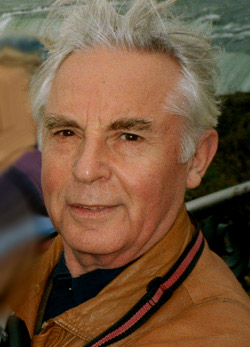Arkady (Abram) Remennik: AUTOBIOGRAPHY
My Nonconformist Story
I was born in Ukraine, on 1928. In 1951 I graduated
from the Graphic Design faculty at the university of Polygraphy. I have
also independently mastered the art of engraving. By the second year
of studying I have already completed the design and illustration for
the “Story of A. Chekhov” in the xylography technique. This
book was printed at the printing house of the university. I have also
completed my final year’s thesis in the same xylography technique.
The university committee that judged the thesis projects, including
the academic A. Sidorov, marked my work at the highest possible marks.
My thesis was the only one done in the xylography technique.
As artists have always felt the pressure of government control and authority.
I am grateful to a famous Russian artist A. Gancharov, a teacher at
the Moscow University of Polygraphy, for introducing me to the great
master of Soviet graphics, V. Favorsky. Favorsky was recognized with
many awards. He constantly experimented with innovative styles and new
directions. This search for innovation caused an angry disapproval from
Stalin. The government labeled Favorsky a formalist, which at the time
was too risky to live with. He remained without the necessities required
for basic existence, even his phone was disconnected. Favorsky and I
began communicating through mail. We sent each other letters through
which we organized meeting dates.
The period afterwards became very troublesome. I have not received an
excellence diploma even though all of my marks, including my thesis
project, have been outstanding. I had to prove my worth to the university
board of directors after which I had finally received the excellence
diploma. However the System was so aggressively conservative that it
would not accept my art, because it was ahead of its time and was against
official governments policy in art. Out of forty-four graduates, forty
stayed to work in Moscow, but I was sent to another republic Uzbekistan
– (bordering Afghanistan). During filling out the job application
forms, an empty counterfeit application page was purposely placed in
between authentic documents. In that counterfeit page, the promised
job placement was changed to another. Instead of working as an art director,
I was made to work as a technical director. As a result the salary was
only half of what I was promised. I had no food or shelter. Also I was
often sent to work at a cotton plantation. I had no time or proper conditions
for real artistic expression. Once I had returned to Moscow, I was not
accepted to any job placements and I was forced to live on occasional
small independent projects. During this struggle, my dedication to art
never went away, I continued to produce art works.
A group of friends and I organized an art studio. We found a studio
location and invited the artist E. Belutin as an instructor. The studio
was named the “New Reality”. We worked with graphics and
painting and continuously developing and perfecting our artistic skills,
and trying to find new directions in art. The studio grew rapidly as
new members joined. What was unusual is that in central Moscow there
was a thriving art studio that was never approved by the Russian government.
At the time this was unacceptable and the Artist Union of the USSR has
confronted our studio. The “New Reality” studio in 1962
organized a large exhibition in “Manezh” exhibition hall
at the heart of Moscow. This exhibition was personally viewed and banned
by Khrushchev. Due to my participation in this exhibition at Moscow’s
“Manezh” exhibition hall, I was not accepted into the Union
of Soviet Artists. As a member of the studio, I was prohibited from
exhibiting my work and I was also not accepted into the Artist Union
of the USSR.
I was trying to get accepted into the Artist Union of the USSR since
1958 and only joined in 1971. The Union later chose me as part of their
jury in the graphic section. Later I began work for the largest printing
houses of Moscow: “Hudojestvennaya Litiratura”, “Detskaya
Litiratura”, “Savetskiy Pisatil’ ”, Inostranaya
Litiratura”, “Savetskaya Rassia” and “Misl’
”. My works have been highly recognized at a yearly jerried contest
called the “50 Best Books”. Many times I won prizes at other
competitions for best book series design. Using the xylography technique
I have created more than fifty portraits of famous artist, writers,
scientists and philosophers. I have also created over five hundred portraits
using a technique that I had developed. During developing this new technique
I have invented a new engraving technique called “paper engraving”.
In 1981 I had been awarded a patent for this invention. This was the
first patent ever given in the art field in the USSR.
The Belutin Studio had finally received recognition during “Perestroika”.
In 1990, at the “Manezh” in Moscow, an exhibition was held
for the Belutin Studio artists and their works. This exhibition enjoyed
great success and recognition. I took part in that event, and two of
my works have been purchase by the Artist Union of the USSR.
Today, I continue to work in graphics and painting. I am now developing
the new techniques.
|
|||||||||||||||||







